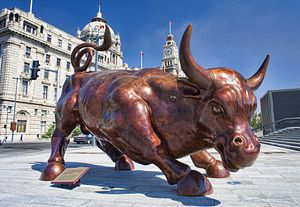Asia made further progress in 2013 in its seemingly inexorable rise to the top of the global economic standings. What might the region’s major economies hope for in the Year of the Horse?
Australia: Tony Abbott’s government has pledged to deliver free trade agreements with major trading partners China and Japan within months. Getting these signed and sealed, while avoiding any further rows with neighboring Indonesia, would mark a major trade win. Treasurer Joe Hockey’s May budget also faces the issue of trimming spending while ensuring the economy does not slip into its first recession since the early 1990s.
China: This year’s goals include ensuring the much-hyped shift away from export-led to domestic-focused growth by giving consumers a greater share of the pie. Implementing promised reforms and avoiding a hard landing in 2014 would do much to appease the populace (and global financial markets) as well as getting to grips with a government debt blowout.
Hong Kong: Maintaining its position as the world’s freest economy, as measured by the Heritage Foundation, along with its high global competitiveness rankings would mark another successful year for the Chinese city-state. Provided the mainland’s economy continues to grow, Hong Kong stocks could achieve the forecast double-digit gains for 2014.
India: Policymakers from Asia’s third-biggest economy have a daunting task in curbing inflation while preventing the economy posting a decade-low GDP growth rate below 5 percent. Avoiding a credit rating downgrade and ensuring the next government enacts reforms capable of maintaining its long-forecast potential will prove major challenges for the year ahead.
Indonesia: Riding out the US Federal Reserve’s “taper” as well as ensuring successful elections will be the main goals for 2014, with the Indonesian rupiah currently testing five-year lows. The Jakarta bourse was one of a number of Asian markets including Shanghai to post a negative return in 2013, so any improvement would be positive for investors in Southeast Asia’s largest economy, now touted as one of the “Mint” countries.
Japan: Prime Minister Shinzo Abe’s “Abenomics” delivered stunning gains for stock investors in 2013, however repeating the 57 percent rise will not be easy in 2014. After firing two arrows of fiscal and monetary expansion against deflation, Abe’s tougher task this year will be credible “third arrow” pro-growth reforms, including the Trans-Pacific Partnership. Avoiding further rows with major trading partner China would also help, since Harry Potter’s Voldemort has no place in trade policy.
Malaysia: Prime Minister Najib Razak’s moves to slash subsidies will come under further political pressure this year, threatening consumer spending although appeasing credit rating agencies. Achieving forecast growth of around 5 percent will rely on increased exports, although according to ANZ, the country’s fiscal reforms and leverage to the electronics cycle may allow it to capture market share from rival exporter Thailand.
Philippines: One of the region’s economic standouts in 2013, the archipelago will be aiming for more of the same despite suffering the damaging effects of Typhoon Haiyan, the deadliest typhoon in the nation’s recorded history. ANZ economists expect growth of 6.9 percent in 2014, although Southeast Asia’s fifth-largest economy will have to deal with the effects of the Fed’s taper, which has seen stocks slide since their May peak.
Singapore: Knocking Switzerland off top spot in the World Economic Forum’s Global Competitiveness Report would be an achievement for the city-state, which is expected to post similar growth this year compared to 2013. However, policymakers face the prospect of a real-estate slump after government-imposed curbs on lending and threatened higher interest rates, while the local bourse has been hit by slower regional growth and capital flight from Asia.
South Korea: President Park Geun-hye’s promised “People’s Happiness Era” has had a good start, with parliamentary approval for the 2014 budget aimed at “economic democratization.” Expansionary fiscal policy should help the economy achieve its projected 3.9 percent growth target despite a potential decline in the trade surplus, although its diplomats face the task of preventing tensions with its neighbors from damaging trade ties.
Taiwan: Taiwan’s stocks and dollar are under pressure thanks to the Fed, while its government has cut its growth forecast to 2.6 percent in 2014 on the back of weaker exports. According to President Ma Ying-jeou, only a breakthrough in the “cross-strait standoff” with Beijing will help its economy move to the next level. Achieving improved ties with its biggest trading partner along with the rest of the region will be key goals for 2014.
Thailand: After suffering its worst start to the year since 1998, the only way is up for the Thai bourse, which according to Bloomberg data has been hit by selling from foreign investors. Bangkok’s challenge in 2014 will be preventing political turmoil and Fed tapering from scaring off investors and damaging the economy, while maintaining an orderly depreciation of the baht.
With studies showing few new year resolutions are achieved, can Asia’s policymakers live up to the challenge in 2014?

































